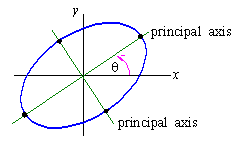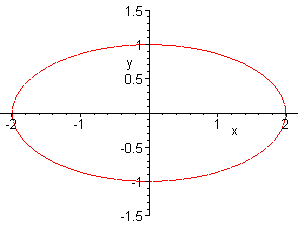Rotation of Conics into Standard Form
The prinicipal axes of a conic of the form
in the xy-plane are the axes which contain the points closest to and
fathest from the origin.

Our goal is to rotate the conic into standard form, or more
accurately, to find the conic in standard form that is rotated to produce the
given conic.
In section 2-9, we saw that the principal axes contain the
points closest to and farthest from the origin. Thus, to find the principal
axes for (2), we find the extrema of f( x,y) = x2+y2
with (2) as the constraint. Lagrange multipliers
subsequently yields
|
Ñg = lÑf Þ
á2Ax+By,Bx+2Cy
ñ = l
á 2x,2y
ñ |
|
Thus, 2Ax+By = l2x and Bx+2Cy = l2y, so that
|
2Axy+By2 = l2xy = Bx2+2Cxy |
|
Solving for y in 2Axy+By2 = Bx2+2Cxy yields
Let us now let q be the angle formed by one of the principal axes
with the x-axis (see the figure above). Then tan( q)
is the slope of that axis, so that comparison to (3) yields
Incredibly, if we now substitute (4) into the double
angle formula for the tangent function
|
tan( 2q) = |
2tan( q)
1-tan2( q)
|
|
|
then (4) yields the much simpler form
Thus, our conic in the xy-plane can be considered the image of a conic in
standard position in the uv-plane.

We say that the conic in the uv-plane is the pullback under rotation of the curve
in the xy-plane.
To compute the pullback, we use the rotation transformation
|
|
é
ê
ë
|
|
|
ù
ú
û
|
= |
é
ê
ë
|
|
|
ù
ú
û
|
|
é
ê
ë
|
|
|
ù
ú
û
|
|
|
In particular, if we replace x and y in the original conic by
then simplifying the result will produce the pullback, which will be a conic in
the uv-plane which is in standard form.
EXAMPLE 7 Find
the conic in standard form in the uv-plane which is the pullback under
rotation of
Solution: Since A = 7, B = -6Ö3, and C = 13, formula (5) results in
|
tan( 2q) = |
-6Ö3
7-13
|
= Ö3 |
|
Thus, 2q = p/3, which implies that q = p/6 . As a result,
the equations (6) lead to
|
|
|
|
cos |
æ
è
|
|
p
6
|
ö
ø
|
u-sin |
æ
è
|
|
p
6
|
ö
ø
|
v Þ x = |
Ö3
2
|
u- |
1
2
|
v |
| |
|
| sin |
æ
è
|
|
p
6
|
ö
ø
|
u+cos |
æ
è
|
|
p
6
|
ö
ø
|
v Þ y = |
1
2
|
u+ |
Ö3
2
|
v |
|
|
Substitution into the original equation then leads to
|
7 |
æ
è
|
|
Ö3
2
|
u- |
1
2
|
v |
ö
ø
|
2
|
-6Ö3 |
æ
è
|
|
Ö3
2
|
u- |
1
2
|
v |
ö
ø
|
|
æ
è
|
|
1
2
|
u+ |
Ö3
2
|
v |
ö
ø
|
+13 |
æ
è
|
|
1
2
|
u+ |
Ö3
2
|
v |
ö
ø
|
2
|
= 16 |
|
Expanding and simplifying then leads to 4u2+16v2 = 16, so that in the uv-plane we have
which is in standard form for an ellipse.



